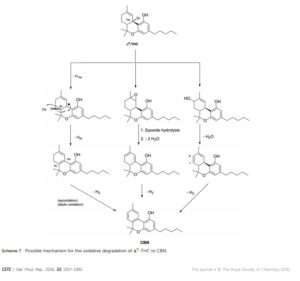CBN is a cannabinoid that is less psychoactive than THC. It is an oxidized form of THC that is known for its sedative effects.


We get many questions about the presence of CBN in distilled oil.
CBN naturally occurs in cannabis. Typical concentrations in refined oils are 1.5% or less .
Concentrations of 4% or more might indicate poorly stored or aged cannabis with prolonged exposure to oxygen.
6% CBN and up might indicate a significant vacuum leak in the distillation system purifying the cannabis oil. This occurs with some frequency in short path distillation systems since they generally rely on large amounts of vacuum grease instead of grease free o-ring seals found on spinning band distillation systems.
Vacuum grease often erodes and gets sucked into the short path systems letting in oxygen. Oxidation of THC leads to high CBN concentrations as well as a very dark distillate.
Vacuum grease is not food grade. The fact that it can get into the distillate on a short path system is problematic. Somewhere down the line a customer is consuming vacuum grease. Yuck!
To avoid CBN know the how and when the material was harvest and extracted. Use distillation systems with O-ring joints that do not require vacuum grease and are virtually leak free.
November 4, 2019 at 4:34 pm
This and other reasons is why your product needs to be tested at various points in the process: from raw feedstock and applied consumables (solvents, filters, etc.) to intermediary points, and in final, consumable concentrations prior to incorporating into end product such as chocolate or vape or suppositories as well as all the ingredients that go into those as well. Another area to look at it post production analysis: that is what happens to your product days, weeks and months after production(?) Ensure packaging is correct and your product doesn’t change due to chemicals in packaging or that your product degrades the packaging materials. Alcohol reduces THC over time so beverages made with a little of a lot can degrade quickly. Food for thought! Cheers
November 4, 2019 at 9:56 pm
Hi other Luke,
Well said. Packaging choice is very important for shelf-life. Proper storage of materials in every step of the process is also important as you’ve said. With concentrates, it can be tough to find a solution. Once the cannabinoids are so purified, they are easily the first thing to become oxidized by air and light. Infusing into food/beverage comes with a different set of challenges. Even the flower market struggles with these issues.
In distillate anyways, CBN is obviously not the only indicator. THC also frequently ends at D8 or D10.
Luke
September 6, 2020 at 11:08 pm
What if I want to CBN? Can I get a bottle of THC and leave it exposed to light and oxygen?
September 8, 2020 at 11:46 am
Light and oxygen will definitely increase your CBN content. There more CBN that exists in your sample though, the harder it is to convert THC to CBN. A lot of conversions using only light/heat/oxygen cap out at around 20-30% CBN. Pure CBN will need a proper chemical workup.
-Luke
September 8, 2020 at 10:55 pm
Do you have an sop for this proper chemical work up my good man?
September 8, 2020 at 10:59 pm
Light heat and oxygen,
Cooking at @ 65 degrees c for extended period of time will get you some cbn conversion…
All I’ve found as far as chemical conversion is an iodine wash but I still can’t find sop for that
.. I know it’s and acid wash to get full conversion of thc to cbn that will retain terpenes where other methods mutilate them
December 31, 2020 at 6:38 am
“Light and oxygen will definitely increase your CBN content. There more CBN that exists in your sample though, the harder it is to convert THC to CBN. A lot of conversions using only light/heat/oxygen cap out at around 20-30% CBN. ”
How to explain with a reaction mechanism
January 1, 2021 at 9:53 pm
Anyone with a good mechanism is unlikely to share.
But the real explanation is that the CBN starts to get converted to something else or other things. In conditions with excess heat or high energy light, even CBN (which is more resistant to degredation) starts to form other products.
If you want CBN for more than research, you will want a more targeted approach.
-Luke
June 19, 2021 at 4:48 am
[…] 1896, was the first cannabinoid that was isolated in its purist form. People actually thought that CBN was responsible for the intoxicating effects of […]
February 17, 2022 at 4:34 pm
The reason I am posting on this random website is to find out if the degradation of THC to CBN (and other byproducts) is dependent on the presence of oxygen. It seems like a pretty straightforward question, but there is very little information on the subject online. The reason I ask is because I’m wondering if THC remains stable under anaerobic conditions.
Reddit has literally nothing. It’s just a bunch of jack*sses suggesting Boveda. I probably won’t be back to check this board, but you would be doing a service to the entire community if you can shine light on this issue